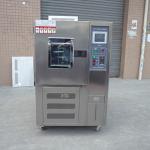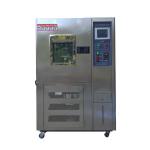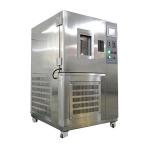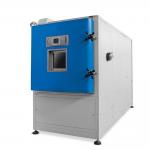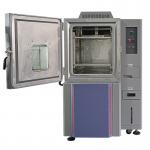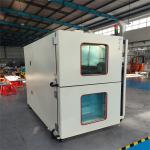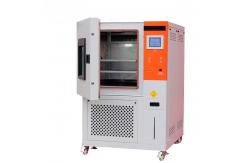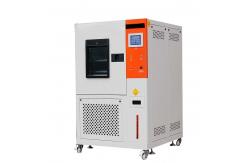In the highly competitive automotive industry, where safety and
performance are of paramount importance, the Customized High-Low
Temperature Test Chamber emerges as a crucial tool for ensuring the
quality and durability of automotive components and systems. This specialized test chamber is designed to subject automotive
parts and assemblies to a wide range of extreme high and low
temperatures. It serves as a vital asset in automotive research and
development, quality control, and production. By replicating the
harsh temperature conditions that vehicles may encounter in
different climates and operating scenarios, it enables
manufacturers to evaluate the performance, reliability, and
durability of various automotive elements. For example, it can test
the functionality of engine components in extreme heat, the
integrity of electronic control units in freezing cold, and the
durability of interior materials under temperature fluctuations.
This helps in identifying potential weaknesses and making
improvements before the products reach the market, ultimately
enhancing the overall quality and safety of automobiles. - Robust and Insulated Chamber Structure
- The test chamber is constructed with heavy-duty materials that can
withstand the rigors of continuous temperature cycling. The walls
are made of thick, insulated panels that provide excellent thermal
isolation. This insulation not only ensures accurate temperature
control but also helps in maintaining a stable internal
environment, minimizing heat transfer to and from the surroundings.
The interior surface is smooth and non-corrosive, preventing any
interaction with the tested automotive samples that could affect
the test results.
- The chamber door is designed with a reliable sealing mechanism to
prevent any air leakage during temperature changes. It is
engineered to open and close smoothly, allowing for easy loading
and unloading of large and bulky automotive components. The overall
structure is built to withstand the mechanical stresses associated
with rapid temperature variations and the weight of heavy samples.
- Precision Temperature Control System
- The temperature control system is highly advanced and capable of
achieving a wide temperature range. It can reach extremely low
temperatures, typically down to -40°C, simulating the coldest
Arctic conditions or winter driving in frigid regions. On the high
end, it can go up to +150°C, replicating the heat generated in
engine compartments or in desert driving scenarios. The temperature
can be adjusted with an accuracy of ±0.5°C, ensuring precise and
consistent testing conditions.
- The system is equipped with rapid temperature change capabilities,
allowing for efficient thermal cycling. It can ramp up or down the
temperature at a rate of several degrees Celsius per minute,
depending on the specific testing requirements. This enables
manufacturers to conduct accelerated life tests and quickly
identify any temperature-related issues in automotive products.
- Comprehensive Monitoring and Data Acquisition
- The chamber is fitted with multiple temperature sensors
strategically placed throughout the interior to monitor any
temperature gradients. This ensures that all parts of the tested
sample are exposed to the intended temperature conditions. The data
acquisition system records the temperature data in real-time and
can generate detailed reports and graphs. These records are
invaluable for analyzing the performance of automotive components
under different temperature profiles and for documenting compliance
with industry standards.
- The control panel of the chamber is user-friendly and allows for
easy programming of different temperature test sequences. Operators
can set specific temperature levels, dwell times, and cycling
patterns to mimic real-world driving conditions or
industry-standard test protocols. The panel also displays the
current temperature status and any alerts or warnings related to
the testing process.
| Model | JTC-80 | JTC-150 | JTC-225 | JTC-408 | JTC-800 | JTC-1000 | | Inside dimension(W x D x H) mm | 40 x 50 x40 | 50 x 60 x 50 | 50 x 75 x 60 | 60 x 85 x 80 | 100 x 100 x 80 | 100 x 100 x 100 | | Outside dimension(W x D x H) mm | 95 x 140 x 95 | 105 x 150 x 105 | 105 x 165 x 115 | 115 x 175 x 140 | 155 x 190 x 140 | 155 x 190 x 160 | | Internal material | #304 Stainless Steel | | External material | Powder coated #304 Stainless Steel | | Temperature range | + 150℃~ - 70 ℃ | | Humidity range | 10% ~ 98% R. H | | Temperature Uniformity ℃ | 0.01 | | Humidity Uniformity % R. H. | 0.1 | | Temperature stability ℃ | ±0.3 | | Humidity stability % R. H. | ±2 | | High temperature ℃ | 100 | 100 | 100 | 100 | 100 | 100 | | Heating time (min) | 20 | 30 | 30 | 30 | 30 | 30 | | Low temperature | 0, -40, -70 | 0, -40, -70 | 0, -40, -70 | 0, -40, -70 | 0, -40, -70 | 0, -40, -70 | | Cooling time (min) | 20, 50, 70 | 20, 50, 70 | 20, 50, 70 | 20, 50, 70 | 20, 50, 70 | 20, 50, 70 | | Air circulation system | Mechanical convection system | | Cooling system | Imported compressor, fin evaporator, gas condenser | | Heating system | Sus304 Stainless steel High-speed heater | | Humidification system | Steam Generator | | Humidification water supply | Reservoir, Sensor-controller solenoid valve, recovery-recycle
system | | Controller | Touch panel | | Electrical power requirements | Please contact us for requirements of specific models | | Accessories | Multi-layer enhanced glass window,test hole, action indicator
light, case lighting barrier shelf x2 | | Safety device | Circuit system load protection, compressor load protection, control
system load protection, humidifier load protection, overtemperature
load protection, fault warning light |
- Accurate Simulation of Automotive Operating Environments
- The primary function of the Customized High-Low Temperature Test
Chamber is to provide a highly accurate simulation of the
temperature conditions that automotive products encounter during
their lifecycle. By precisely controlling the temperature, it
allows manufacturers to assess how components and systems will
perform in different climates and usage scenarios. For example,
testing the performance of a car's braking system in both extreme
cold and hot conditions can help identify potential issues such as
brake fade in high heat or reduced braking efficiency in the cold.
This information can then be used to optimize the design and
materials of the braking system, enhancing its overall reliability
and safety.
- The ability to conduct cyclic temperature tests is also a key
function. This involves repeatedly subjecting the samples to
temperature changes, which can help uncover latent defects or
weaknesses that may not be apparent under static temperature
conditions. For instance, an automotive sensor may work fine
initially at a single temperature but develop faults after several
cycles of temperature variation. The test chamber can detect such
issues and prompt manufacturers to make improvements.
- Compliance with Automotive Industry Standards and Regulations
- The automotive industry is subject to numerous standards and
regulations regarding product quality and safety. The High-Low
Temperature Test Chamber is a reliable tool for ensuring
compliance. For example, many automotive components need to meet
specific temperature performance requirements set by organizations
like the Society of Automotive Engineers (SAE) or international
regulatory bodies. By using this chamber to conduct tests in
accordance with these standards, manufacturers can prove that their
products are fit for use and gain market access.
- Regulatory bodies also rely on accurate test results obtained from
such chambers to enforce safety and quality regulations. It serves
as a means for inspectors to determine whether automotive products
can withstand the temperature extremes they may encounter in
real-world driving, thereby protecting consumers and ensuring the
overall integrity of the automotive market.
- Research and Development Support for Automotive Innovation
- In the field of automotive research and development, this test
chamber is an invaluable asset. It allows engineers and scientists
to explore new materials and design concepts. For example, in the
development of lightweight yet durable automotive body panels, the
chamber can be used to evaluate how different materials and
manufacturing processes respond to temperature changes. This data
can then be used to optimize the panel design, select the most
suitable materials, and improve the manufacturing process to
achieve better performance and durability.
- The detailed data provided by the test chamber also helps in the
development of advanced automotive technologies. For instance, in
the research of next-generation battery systems for electric
vehicles, understanding how the battery cells and their associated
components perform under different temperature conditions is
crucial. The chamber can be used to test and optimize the thermal
management of battery packs, improving their lifespan, performance,
and safety.
- Stringent Manufacturing Process
- The Customized High-Low Temperature Test Chamber for the Automotive
Industry is manufactured under strict quality control procedures.
Each component, from the heating and refrigeration units to the
temperature sensors and control circuitry, is carefully sourced and
inspected for quality and performance. The assembly process is
carried ou
|
